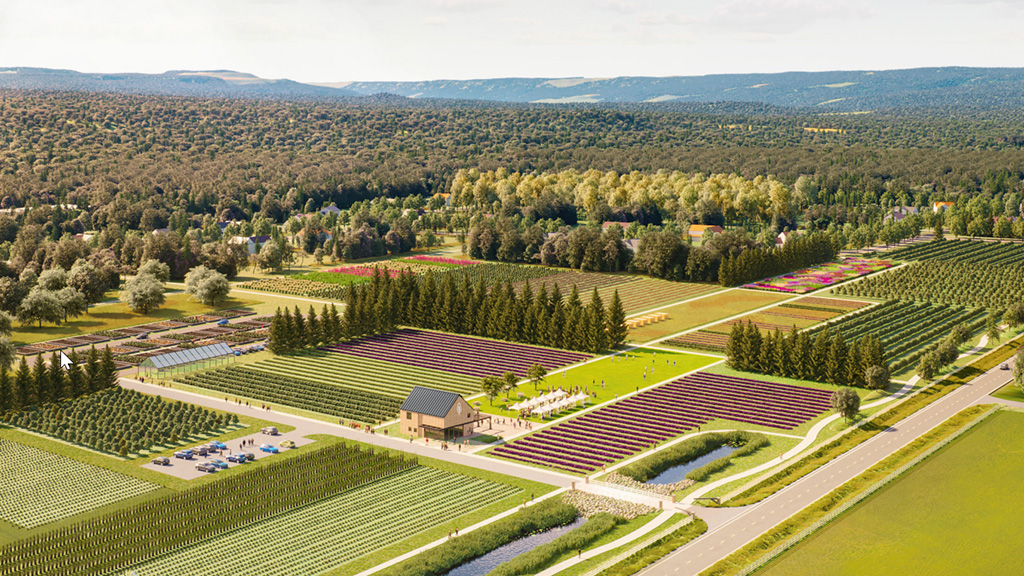A new development being proposed in Thornbury, Ont. is giving different meaning to living on a farm, combining a residential community with agriculture.
Thornbury Acres is a residential farm co-operative on large lots that will allow the condominium owners of each homestead to utilize agricultural and recreational common elements.
The development will also include a barn and community area as well as trails.
“We’re converting what was formerly zoned for a golf course into effectively what will be the residential development land,” said Harley Valentine, a partner with Castlepoint Numa. “The farm aspect is through a partnership that we’ve done with a neighbour of ours that has a 50-acre parcel, 25 of which has been laying barren that we will reactivate through this development.”
Developer Castlepoint Numa has submitted a zoning bylaw amendment application to redevelop the lands located at Grey County Road 40 and Grey County Road 2 in the Town of Blue Mountains.
“We made an application, it’s deemed complete. We received staff comments and now we’re just waiting for a report and approvals,” Valentine said. “We hope to be in the ground delivering the farm and the barn program in early 2024.”
The proposal maintains 74 per cent of the land in a rural landscape condition, states the project website, adding a minimum of 60 per cent of the original land holding will remain available for the active primary agricultural or recreational use. The 150-acre site will include 37 residential units, have a 50-acre farm program and 40 acres of passive recreation. Lots will range in size from 1.3 to 1.5 acres.
“There was a barn on the land, it burned down in the ‘90s and one of the exciting things about this project, it’s going to restore a farm that had previously gone barren,” Valentine said. “We’re going to rebuild the barn, we’re going to re-establish that farm and then nestle in the 37 units around the farm tucked in behind so that it’s hidden from the road. Really the main visual feature will be a new frontage of active agriculture.”
“You own your unit of land at Thornbury Acres…and you’re tied to the balance of the 90-acre compound, which is both farm and passive recreation. You’re also required to support that through a condominium fee.”
It is the first project of its kind in Ontario, but other models exist in B.C. and throughout the United States.
“What’s happening across Canada today is the average farm size is becoming larger, the average age of the farmer is becoming older because of the consolidation that is happening,” said Valentine.
“What Thornbury Acres does is it really underscores the value of small-scale farming. We hope to use it as a launchpad for education and awareness around the power of small-scale regenerative farming. We have an agricultural advisory board and a lot of them are active regenerative farmers.”
One of the farmers serves 35 families from just one acre of land and provides them with 18 baskets a year of produce.
“There is a worldwide trend towards this farming practice that turns its back on commercial farming, heavy machinery, pesticides,” Valentine explained. “This idea of high intensity planting, smaller rows, bountiful outputs, that is really the focus of our farm program, and we hope to use this community as a launchpad to generate further learnings.”
The team is about to bring on a design architect.
“Our vision is that this is going to be a very tightly curated community and that there will be a number of home typologies that repeat throughout. There will also be an iconic architectural barn that will of sort of anchor and also create a sense of destination for this community,” Valentine stated.
“A selected design architect will be creating an agrarian home or a homestead which would be an alteration on the modern ‘A’ frame. They’re going to be offered from 1,500-square-feet to 5,000-square-feet. It will be slab-on-grade construction and they will be serviced by well and septic.”
One of the unique things about the lot plan is a 30-foot lot buffer around each property.
“It’s going to create that sense of rural privacy that’s typical for larger lots in this area…so there is no need to build fences,” said Valentine. “We want to be the antithesis to the typical tract housing development that you would encounter through the GTHA.
“Between you and your neighbour there will be 60 feet of natural wooded area and that’s consistent throughout the development.”
Follow the author on Twitter @DCN_Angela



Recent Comments